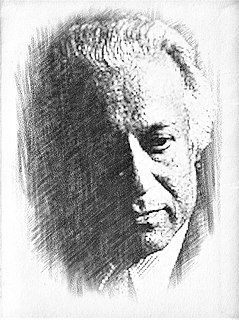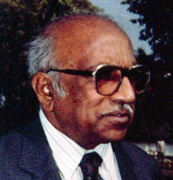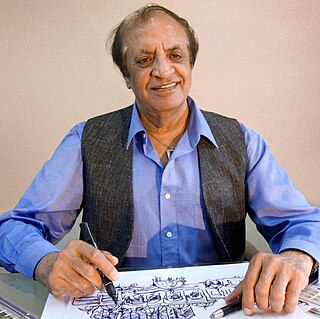
Gauhati University, also known as GU, is a collegiate public state university located in Guwahati, Assam, India. It was established on 26 January 1948 under the provisions of an Act enacted by the Assam Legislative Assembly. It is the oldest university in Northeast India.

Achyut Purushottam Kanvinde was an Indian architect who worked in functionalist approaches with elements of Brutalist architecture. He received the Padma Shri in 1974.

Joseph Stein was an American architect and a major figure in the establishment of a regional modern architecture in the San Francisco Bay area in the 1940s and 1950s during the early days of the environmental design movement. In 1952, he moved to India and in 1955 was tasked with the planning of Durgapur in West Bengal, India along with Benjamin Polk. He was commissioned with this task in order to facilitate the establishment of Durgapur Steel Plant later on in 1959 followed by the Durgapur Steel City and Township. He is noted for designing several important buildings in India, most notably in Lodhi Estate in Central Delhi, nicknamed "Steinabad" after him, and where today the 'Joseph Stein Lane', is the only road in Delhi named after an architect. He is also famous for being the architect of the scenic Indian Institute of Management Kozhikode's campus. The Government of India awarded him the fourth highest civilian award of Padma Shri in 1992. His works remain even more relevant in the modern context as need for sustainable and humane architecture is felt.
Rita Chowdhury is an Indian poet, novelist and Sahitya Akademi Award recipient in the world of Assamese literature. She has been an associate professor in Cotton College, Guwahati, Assam in Political Science Department since 2001. She is currently the director of National Book Trust, India.

'Bayanacharya' Shri Ghanakanta Bora Muktiyar is one of the most eminent exponents and gurus of Sattriya dance, a major classical dance tradition of Assam, India. He is also a renowned instrumentalist, choreographer and author. He has won the prestigious Sangeet Natak Akademi Award in 2001.

Habib Rahman was an Indian architect who worked on the Delhi Zoological Park, Gandhi Ghat, and Rabindra Bhavan in New Delhi.

Raghunath Mohapatra was an Indian architect, sculptor, and a Nominated Member of Rajya Sabha. He was awarded Padma Shri in 1975 and Padma Bhushan in 2001. He was awarded Padma Vibhushan in 2013 on occasion of 64th Republic Day of India.

Reeta Devi Varma is an Indian social worker and the founder of the Delhi-based non governmental organization, Ila Trust. She was honored by the Government of India, in 2012, with the fourth highest Indian civilian award of Padma Shri.
Jugal Kishore (1915–2012) was an Indian homoeopathic physician and the founder Director of Nehru Homoeopathic Medical College and Hospital, New Delhi, a Government of Delhi undertaking. He was honored by the Government of India, in 2012, with the fourth highest Indian civilian award of Padma Shri.
Bir Bhan Bhatia was an Indian physician and a former member of the Legislative Council of the United Provinces in the British India. The Government of India honoured him in 1954, with the award of Padma Shri, the fourth highest Indian civilian award for his contributions to medicine, placing him among the first recipients of the award.
Ahindra Choudhury (1896-1974) was an Indian actor, director, theatre personality and the co-founder of Photo Play Syndicate, a Kolkata-based art organization for bioscope shows. A winner of the Sangeet Natak Akademi Award in 1958, Choudhury was honoured by the Government of India in 1963 with the award of Padma Shri, the fourth highest Indian civilian award, for his services to the nation.

Nagarur Gopinath was an Indian surgeon and one of the pioneers of cardiothoracic surgery in India. He is credited with the first successful performance of open heart surgery in India which he performed in 1962. He served as the honorary surgeon to two Presidents of India and was a recipient of the fourth highest Indian civilian award of Padma Shri in 1974 and Dr. B. C. Roy Award, the highest Indian medical award in 1978 from the Government of India.

Urmila Eulie Chowdhury was an Indian architect who worked during the mid-to-late 20th century. She worked in the fields of general architecture, landscape architecture and design, and was also a teacher and writer. She was a pioneer woman architect working in India. Some sources state that she was also the first female architect in Asia. After her education she worked in close collaboration with Le Corbusier in the planning design and construction of the city of Chandigarh.
Shobha Deepak Singh is an Indian cultural impresario, photographer, writer, classical dancer and the director of Shriram Bharatiya Kala Kendra, a Delhi-based cultural organization which promotes music and performing arts, through its schools and stage shows. She is known for her contributions for the revival of Mayurbhanj Chhau, a tribal martial dance form from Odisha. The Government of India awarded her the fourth highest civilian award of the Padma Shri in 1999, for her contributions to Arts and culture.

Dinesh Nandini Dalmia, also written as Dineshnandini Dalmia, was an Indian poet, short story writer and novelist of Hindi literature. She was the fifth wife of Ramkrishna Dalmia, founder of the Dalmia Group, and three of his four previous wives were still alive and married to him when she became his fifth wife. Nevertheless, she positioned herself in opposition to gender discrimination and purdah system, and published poems, prose poems, short stories and novels on the theme of women's emancipation. Shabnam , Niraash Aasha, Mujhe Maaf Kama and Yeh Bhi Jhooth Hai are some of her notable works. The Government of India awarded her the third highest civilian honour of the Padma Bhushan, in 2006, for her contributions to literature. In 2009, India Posts released a commemorative stamp on her.
Suresh Kumar Neotia (1936–2015) was an Indian industrialist, entrepreneur, art collector, philanthropist and the co-founder of Ambuja Cements and associated companies. He was the chairman of the Group till 2009 when he relinquished the position in favor of his co-founder, Narotam Sekhsaria, and remained as the Chairman Emeritus of the Group until his death. He was a recipient of Harvard Business School - Economic Times Award and was involved in many social activities which included the promotion of cultural organizations such as Anamika Kala Sangam and Padatik. The Government of India awarded him the third highest civilian honour of the Padma Bhushan, in 2008, for his contributions to trade and industry.

Prem Nath, is an Indian architect with a wide spectrum of work. He is the founder of Prem Nath and Associates, an architectural firm based in Mumbai.
Mahendra Raj was an Indian structural engineer and designer who contributed to structural design of many buildings in India including the Hall of Nations at the Pragati Maidan in Delhi and the Salar Jung Museum in Hyderabad. Raj's work is considered pioneering for its engineering solutions for exposed concrete buildings and much of his work is seen as telling the history of post-independence India. In a career spanning six decades, he collaborated with architects including Le Corbusier, B. V. Doshi, Charles Correa, and Raj Rewal, and contributed to the structural design for more than 250 projects.

Kuldip Singh was an Indian architect and urban planner known for his Brutalist architecture designs.
Shiv Nath Prasad was an Indian architect and urban planner known for his Brutalist architecture designs. He was also called the "Le Corbusier of India".














